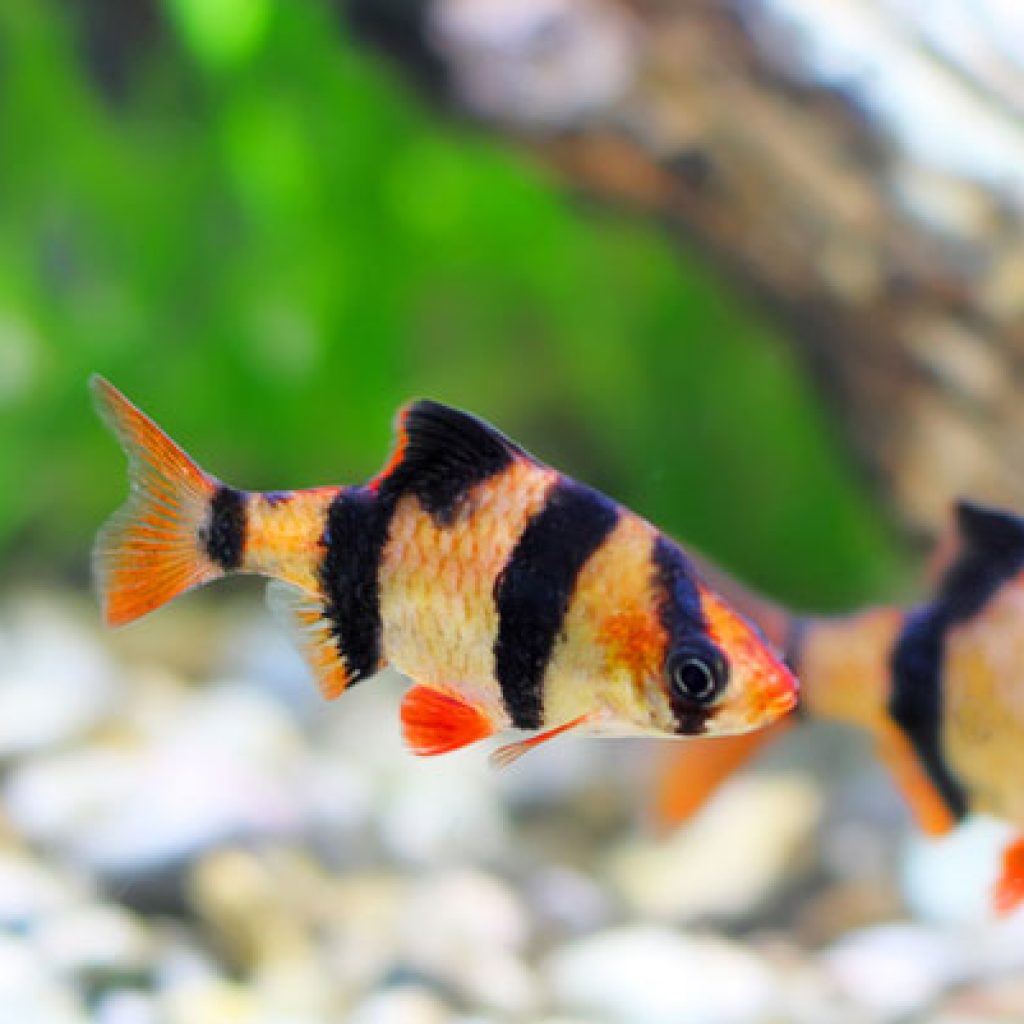Apart from bright and vivacious, the tiger barb fish, unlike its namesake which happens to be a best, grows only up to a maximum of 3 inches even after reaching adulthood and is extremely easy to be taken care of.
The black stripes against their gold or silver foiled body make the species recognizable right away. If you own a tiger barb and are looking forward to forming a clear insight into its healthy diet, then read on.
See Also:
What do you feed a pet tiger barb?
Quite like all the other fishes, tiger barbs too can be fed both store-bought and homemade foods. In the following section, we will elaborately discuss the types of nourishment that must be included in the fish’s diet without fail.
- Flakes
The fact that flakes are the go-to food of all aquarium fishes shouldn’t come as a surprise to our readers mainly because they straightforwardly comply with the nutritional requirements of the tiny creatures.
Always look for high-quality flakes that will stay afloat on the surface of the water for a fair amount of time thus, helping your pet to steer away from the hassle of first finding the tiny bits and then consuming them.
Also, because tiger barbs are omnivores, picking flakes that contain at least one variant of meat in its list of ingredients will be preferable.
- Pellets
Coming to the next most popular food in the fish world, pellets, some of them are curated from the amalgamation of meat-based foods such as squid, krill and herring and vegetable extracts like papaya, apricot, zucchini microalgae, spinach peas and the like.
The chief objectives of these hybrid pellets are to enhance the color and glow of its coat and boost the immune system of the fish over time.
- Live foods
When it comes to living foods, bloodworms and brine shrimps are undoubtedly the favorites of the tiger barb from this category. Bear in mind, live foods are indispensable during their breeding phase as protein-rich foods are known to be the superlative catalyzers of spawning.
Furthermore, live foods are rich in nutrients that qualify as imperatives for the 3-inch creatures but, you should always double-check their source because more often than not, they contain parasites capable of gravely damaging the health of the barb fish.
Aquarists are of the opinion that you should take to culturing the food yourself, especially when there is a tiger barb fry to feed and which is only adept at ingesting freshly-hatched brine shrimp.
- Frozen foods
If you feel that live foods can mess up the water inside the tank or you don’t always have enough time to cultivate them, freezing the grub is a prudent recourse.
However, you must know that frozen food lags slightly behind the rest in terms of nutrition but, they can still be tagged as beneficial substitutes.
- Freeze dry foods
Freeze-dried foods are a benign alternative for life foods that can induce a string of irrevocable diseases in the tiger barb. Evidently, when the food is dried through freezing, all the notorious parasites and pathogens are destroyed leaving you with 100% safe sources of food for your fish.
Before serving the freeze-dried food, soak their cubes in a bowl of aquarium water for some time so that they do not later expand in the fish’s stomach and lead to unnecessary bloating and constipation or similar digestive glitches.
Homemade food
If you want to be 100% certain about what you are feeding your fish and have sufficient time to curate its meal then, homemade food will inexorably be the best solution.
You can try boiling vegetables like cabbage and zucchini mildly or prepare mashed beef depending on whichever of them is readily available at your place (nutrition-wise, animal protein weighs more than the ones derived from veggies).
When preparing the mashed beef, add vegetables akin to carrots, spinach and peas, raw peeled fish and some gelatin to bind the ingredients together and maintain a thick consistency.
If it is the first time that you are offering your tiger barb this dish, it can linger around the food for some time before eating it and thereby, it becomes a part of your duty to get the tiny thing accustomed to this brand new delicacy.
Once the fish successfully identifies that this unfamiliar chunk is nothing else but food, it will show no signs of doubt while having it the next time you offer the same. Nonetheless, if you discover that there’s an uneaten piece of beef paste lying around at the bottom of the aquarium, remove it immediately before it contaminates the water.
How much and how often should I feed my tiger barb?
The appetite and digestive system of fishes largely differ from that of the other domesticated animals and this is more or less that reason why you should always be careful about the amount of food you are serving them.
Both overfeeding and underfeeding the tiger barb can meddle with their natural lifespan and ruin their health to such an extent that it will disturb the physical environment for the rest of the fishes in the tank.
According to experts, you should not feed your tiger barb fish more than once or twice a day. Additionally, the kind and size of the food also influence the optimal amount that the fish should be feeding on at once.
For instance, if you are allowing your pet to munch on the larger versions of pellets or flakes, then you must correspondingly curtail their numbers and vice versa.
A thumb rule is, offer them food that they can eat within the first 5 minutes; but, if you are feeding them twice, the span should be reduced to 3 minutes in each turn.
Let’s not forget that tiger barbs are exceptionally greedy and can eat very aggressively and quickly, meaning, the feeding schedules should be adjusted strategically and most importantly, the feeding habit should suit the particular fish you own.
What do tiger barbs eat in the wild?

In the wild, tiger barbs thrive in shallows of slow-flowing streams but, sometimes they also grow well in small water bodies and swamp lakes. Considering the diverse array of habitats that the fishes are adaptable to, they can proficiently acclimatize in a home aquarium.
Tiger barbs are principally omnivores in the wild and gorge on everything that is available without demur; small insects including insects, algae, crustaceans, and even plant matter are some of their favorite refreshments.
Keep in mind that the hostile nature of tiger barbs drives them to eat nearly every single nibble that is offered to them and therefore, in a home aquarium they must be supplied with a complete and balanced diet comprising freeze-dried foods, flake foods, live foods, vegetables, and pellets.
What vegetables can tiger barbs eat?
Vegetables like carrots, peas, Brussels sprouts and pumpkin are the ultimate resorts for tiger barbs but, they must be fed in moderation. Spinach, cabbage and kernel leaves can be great alternatives too but, there’s a little something that you can do to eradicate their stiffness and make them suitable for easy digestion.
Wash the leaves of the vegetables that you will be furnishing your tiger barb with multiple times and then, heat it in the microwave for a good 3-5 minutes. This procedure breaks the celluloid barriers of the leaves to make them tender and trouble-free for the body to absorb its nutrients.
For the solid vegetables, on the other hand, boil them optimally so that they are neither too hard to gulp, nor too soft to chew. Vegetables must be chopped into minuscule morsels before dropping them inside the tank for the fishes to get a hold on them without any added trouble.
What fruits can tiger barbs eat?
There is no clear evidence that proves that tiger barbs have an affinity for fruits; hence, as a replacement of aiming at the darkness with your assumptions, you should avoid feeding tiger barbs fruits altogether. Nonetheless, if you at all wish to change their palette and give them a treat once in a while, fresh fruits like apple, grapes, papaya, and avocado can work your way.
Frequently Asked Questions (FAQ)
How long can tiger barbs go without food?
The average duration that tiger barbs can go without food is about 2 weeks or slightly more than that; nevertheless, the configuration can be different in distinct cases.
Owners who go off to trips leaving their pets on their own tend to overfeed the fish so that the latter can depend on their reserve during times of crisis.
A couple of weeks sans food will not starve the creature to death but, unclean water in the aquarium would inescapably deteriorate their condition. If you spend the same period without changing the water or at least filtering it, the milieu will make them sick, sometimes even to death.
Much like Betta fishes, for tiger barbs too, the 2-week survival bar is their highest threshold. Aquarists would not recommend you to put their endurance skill on the test when you are away; rather, it would be sagacious to ask one of your friends or someone from the family to look after the fish and feed it every second day if not every day. Otherwise, you have another choice and that is an automatic food dispenser; with this equipment at your disposal, you will be spared from worrying about the schedule of barb’s meals and the amount they are being fed. All you have to do is, set the timer abiding your routine and the rest will be conformed to.
Are tiger barbs aggressive?
Specifically, tiger barbs are grouped under the section semi-aggressive tropical fishes because of their cold disposition and inclination to chase down slow or long-finned fishes that come within its vicinity.
But, as because the gorgeous fishes can be domesticated, they are swayed towards living with mates for companionship and social reasons, inferring that you should always keep them in even numbers; otherwise, they can let their negative temperament accentuate and distort the peaceful ambiance for the other fishes in the aquarium.
Even so, you might sometimes spot the tiger barbs disagreeing amongst themselves, more than ever the first time they are introduced with one another in the tank. But, let us acquaint you with the veracity that this is the case with most fishes as they are very possessive about their territories and wouldn’t let anyone and everyone cross over the demarcations that they have for themselves.
As far as we know, this is not a gospel truth characterizing the tiger barbs; with good practice, their aggression can be defused within their own group and against their contemporaries in the tank.
Can tiger barb eat eggs?
Unfortunately, whenever there’s an opportunity, tiger barbs are tempted to eat their own eggs. This is why, it is often instructed to keep a separate breeding tank that can be used as the other base for the fry.
To come down to one breeding pair, you should at least have half a dozen of them in the tank and permit them to pair off. If possible, condition the breeders mostly with live foods and once they exhibit signs of establishing, break the pair and put them into independent tanks. It is generally the after they are placed into the tank that they commence spawning.
It is right after the spawning that their rapacious appetite is triggered and consequently, they end up attacking the eggs and fry.
If you do not have the option of bringing in a separate tank but, genuinely want to initiate breeding in the tiger barbs, fill in the bottom of the tank with marbles; this is because, during spawning, the eggs will fall into the gaps of the marble stones and subsequently be out of reach of the adults.
